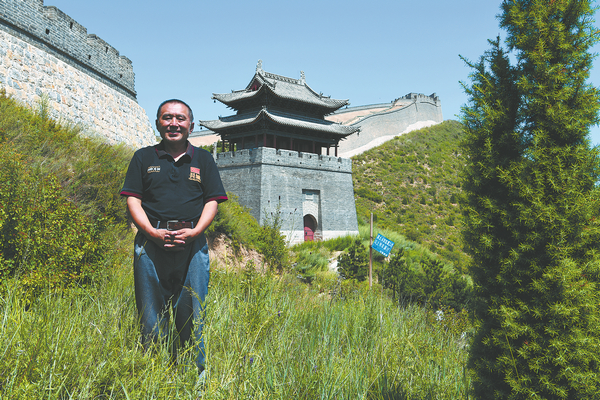Award-winning protector still passionate for Great Wall
Updated: 2024-07-17

Yanmen Pass is a majestic view in winter. YANG JUNFENG/FOR CHINA DAILY
Dedicated visionary shares the culture and resources of the historical structure with photos, researches and the founding of a society, Yang Feiyue reports in Xinzhou, Shanxi province.
Yang Junfeng's eyes light up and a childlike smile spreads across his face the moment he sits down and shares his experiences of the Great Wall. Although gray hairs have sprung all over his head, the man in his 60s has a sturdy build and is full of vigor, a result of his years of outdoor excursions.
He speaks fast, sometimes even tripping over his words as if trying to cram as much information about the Great Wall as he can in a limited time to an audience during the opening ceremony in early July of a Great Wall-themed tourist program in Daixian county, Xinzhou city, Shanxi province.
"There's a watchtower that has a carved floral pattern dating back to the Ming Dynasty (1368-1644) and you can also find a stone tablet that bears traffic instructions," Yang says about the distinctive features of the Yanmen Pass in Xinzhou, an important point of the Great Wall that runs more than 20,000 kilometers on the northern fringes of the country, which defended Chinese empires.
Great Wall resources are scattered across 15 provinces, autonomous regions and municipalities, including Hebei, Beijing and Shanxi. The National Cultural Heritage Administration has identified 4,266 points and segments of the Great Wall from various dynasties in Shanxi, spanning about 1,400 kilometers.
Xinzhou has the largest distribution of the Great Wall in Shanxi, with historical records indicating that 13 of its 14 counties and districts host constructed sections.
According to recent surveys by related cultural relics departments, there are 248.8 kilometers of well-preserved sections of the Ming Dynasty Great Wall in Xinzhou, as well as 229.9 kilometers of well-preserved sections of Wall structures before the Ming, such as the Warring States Period (475-221 BC), Eastern Han Dynasty (25-220) and Northern Wei Dynasty (386-534).
Having spent more than three decades trekking to almost all of the existing parts of the Wall in Xinzhou and recording precious images with his camera, Yang has come to know the historic structure like the back of his hand.
"I haven't counted how many photos I have taken because I have been continuing to record it," Yang says.
At the tourism season launch ceremony, 202 of his photos were on display, exposing visitors to the magnificence of the Yanmen Pass and the great changes surrounding it.

Yang Junfeng stands before Pingxingguan, a Great Wall pass, in 2017. China Daily
Inspired to study
Born and raised in Xinzhou, Yang remembers that as a child, he would stare at the rammed earth-made lumps as he herded cattle.
As he got older, he began to understand the profound history and culture behind the "lumps". Yang took a train in 1991 to Jiayuguan, a well-known pass at the western end of the Great Wall dating back to the Ming Dynasty in northwestern China's Gansu province.
"It was a long trip that took days," recalls Yang, then working as a reporter at a local newspaper.
On the journey, he came across Gao Fengshan, the curator of the Jiayuguan Great Wall Museum. Yang remembers how Gao held out his business card and told him that Shanxi possesses many Great Wall resources.
"It inspired me to study them," Yang says. Since ancient times, Shanxi's geographical features of mountains and rivers have made it strategically important for military affairs. It served as a border between the nomadic peoples of the grasslands and the agricultural peoples of the Central China Plains, as well as a place of cultural exchanges between the Han and other ethnic groups, he explains.
To rigorously protect the area around the capital, the Ming Dynasty constructed inner and outer walls, both of which intersected in Xinzhou, Yang says.
As he surveyed the Great Wall sections, Yang says he was pained to see they had suffered damage.
"The northwestern part of Shanxi has often seen strong winds and abundant sandstorms, which cause natural damage," Yang says.

A section of the Wall runs across the green mountains in Xinzhou, Shanxi province. YANG JUNFENG/FOR CHINA DAILY
Additionally, many sections of the Wall and fortresses are located in sparsely populated mountainous areas, where villages are generally poor.
After the Great Wall lost its military defense function, the impoverished villagers living nearby used its materials to build houses, causing significant damage, he observed.
"Worse still, the hard access to those off-beaten tracks made it more difficult to detect and address the damages to the Wall," he says.
In 2000, Yang spotted a modern concrete road being built within the ancient section and became very anxious.
"It was a big compromise to the cultural relics and historical appearance," Yang says.
He took immediate action by reporting the problem to a local news outlet, which grabbed the attention of the local authorities.
It didn't take long before modern construction was called to a halt and gave way to a gravel path matching the surroundings.
In 2009, Yang founded the Xinzhou Great Wall Society, which is under management by the local cultural heritage administration.
The society has since played a positive role in Great Wall surveys, studies, promotion and protection, delivering many publications that provide crucial decision-making references for local preservation and development efforts of the Great Wall.

Winter view of the Yezhukou section of the Wall in Xinzhou. YANG JUNFENG/FOR CHINA DAILY
Positive changes
The Great Wall section in Xinzhou boasts rich cultural heritage and sizable sections that stretch the area, making its protection challenging, Yang notes.
"I hope to do my part in protecting the Great Wall, help more people understand its immense value and curb its destruction," Yang says.
Over the years, Yang has dug into the history and culture of Yanmen Pass, contributing to the area's tourism development.
He has also supported major publicity events, such as Yanmen Pass-themed photography competitions, which have helped put the area on the tourist map.
Du Juan, a local writer, joined Yang's team five years ago.
"I had just finished writing about the culture of counties along the Yellow River and Yang informed me of the grand theme of the Great Wall in Xinzhou," Du says.
Du has since explored the Great Wall sections across Xinzhou, as well as those in Shaanxi province and the Inner Mongolia autonomous region.
"Those journeys led me to discover that Xinzhou has amazing, diverse pieces of the Wall," she says.
She has written essays about the Great Wall and stories about guardians in Xinzhou that have put a human touch on the wall, endearing it to the public.
Du is now focusing on the development of a national Great Wall cultural park and the roles of culture and tourism in rural vitalization along the Wall.
In 2015, Xinzhou incorporated the Great Wall into its 2016-20 plan for national economy and social development. Two years later, the city proposed to continue tapping into the Wall's resources and value.
Xinzhou has also built a Great Wall museum and launched maintenance projects in multiple sites, such as historical military campsites.
Key sections of the Great Wall have been marked for protection and officers are appointed in these efforts.
Yang has noticed the positive changes.

More than 200 photos by Yang are on display at a travel promotion event in the city. YANG JUNFENG/FOR CHINA DAILY
He took three photos of Yanmen Pass from the same angle over 20 years, showing the ecological changes and sharing them with others.
Barren, snow-covered mountains jump into view in the first photo taken in the early 2000s, evoking a sense of harsh desolation. The presence of green trees emerges on the mountain slopes in the second photo taken 10 years ago.
In the third photo, taken last year, the trees have grown into a lush forest.
"The Great Wall used to be desolate and imposing. Now it has become gentler and full of vitality," Yang says.
To continuously improve the ecological environment of the Yanmen Pass scenic area and the surrounding Great Wall, Daixian county has implemented afforestation projects in a mountainous area of more than 2,600 hectares in recent years, where pine, spruce, wild apricot and elm trees have been planted.
Yang's contribution has earned him multiple accolades, including the Ten Great Wall Guardian award by the Xinzhou government.
"The Great Wall has given me a mission and greatly enriched my life," Yang says, adding that the awards serve as an incentive for him to carry on.
He says he will keep enrolling people in the Xinzhou Great Wall Society so they can join in the efforts for Great Wall protection and studies.
Yang is now working on compiling years of Great Wall studies into books for the public to understand and appreciate its charm.
"Hopefully, I can offer some useful information on Great Wall protection and utilization," he says.
Contact the writer at yangfeiyue@chinadaily.com.cn



